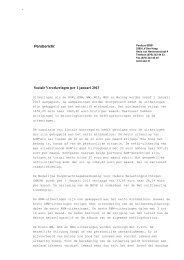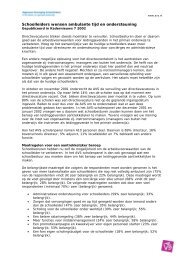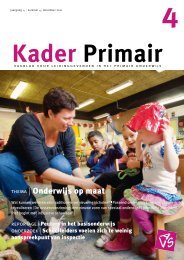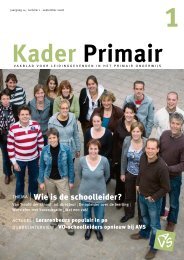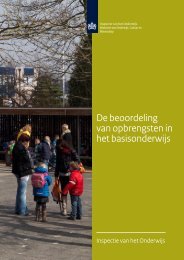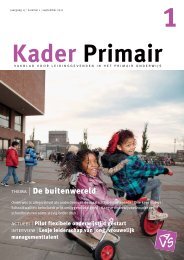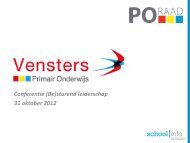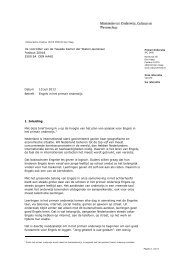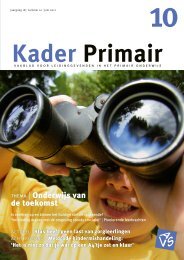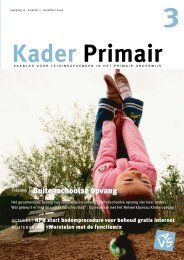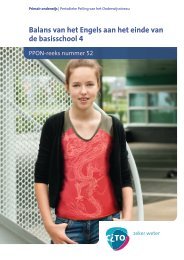Esha Magazine January 2012.pdf
Esha Magazine January 2012.pdf
Esha Magazine January 2012.pdf
You also want an ePaper? Increase the reach of your titles
YUMPU automatically turns print PDFs into web optimized ePapers that Google loves.
magazine<br />
Bullying at school:<br />
Prevention and<br />
Intervention<br />
JANUARY 2012
C O L O P H O N<br />
ESHA magazine is the offi cial magazine of the European School<br />
Heads Association, the Association for school leaders in Europe.<br />
ESHA magazine will be published eight times per school year.<br />
You are welcome to use articles from the magazine but we would<br />
appreciate it if you contacted the editor fi rst.<br />
Subscription<br />
The ESHA e-magazine is free of charge. You can register through<br />
the internet at www.eshamagazine.com<br />
The ESHA Executive Board<br />
Ton Duif (President), Chris Harrison (Board member), Clive Byrne<br />
(Board member), Jukka Kuittinen (Board member), Solveig Dahl<br />
(Board member)<br />
About ESHA<br />
ESHA is a Foundation that consists of 32 Associations of Heads<br />
and Educational employers in 25 European countries in primary,<br />
secondary and vocational education.<br />
Contact ESHA<br />
Visiting address: Nieuwegracht 1-3 Utrecht Netherlands<br />
Postal address: Postbox 1003, 3500 BA Utrecht Netherlands<br />
e-mail: e.dejong@avs.nl, www.esha.org<br />
The Editorial team for the magazine<br />
Ton Duif (editor), Chris Harrison, Clive Byrne, Roy Tedscoe, Ellen de Jong.<br />
This edition is sponsored by the AVS, the Netherlands.<br />
Layout and design<br />
Thoben Offset Nijmegen<br />
www.thoben-offset-nijmegen.nl<br />
2 ESHA MAGAZINE JANUARY 2012
In this issue<br />
<strong>January</strong> 2012<br />
4 Column Ton Duif<br />
6 Political infl uence on education<br />
10 An account of a six country collaborative<br />
Comenius project<br />
16 Euthanasia: an issue that refuses to die<br />
20 Prevention & Intervention<br />
30 Nyt ledelsesværktøj<br />
37 Schweiß und Tränen: Der PISA Erfolg Shanghais<br />
42 Primary School Heads Association in Bosnia<br />
and Herzegovina<br />
48 Career development of teaching professionals<br />
with managerial responsibilities<br />
52 The widening quality gap between Finnish vocational<br />
versus general education<br />
ESHA MAGAZINE JANUARY 2012 3
COLUMN TON DUIF<br />
It’s<br />
Comenius<br />
time<br />
Dear ESHA friends and members,<br />
The European Commission has launched the new call for programs<br />
in the Life Long Learning (LLL) programs Erasmus and Comenius.<br />
To enter such a program, you have to submit a bid refl ecting one<br />
of the topics in the LLLprogram. Because ESHA represents school<br />
heads in primary, secondary and vocational education, we are<br />
involved in the Comenius program.<br />
ESHA represents 89,000 school heads in 25 countries in Europe.<br />
This makes us a wanted partner in a lot of Comenius bids. Because<br />
these bids must have been submitted before the beginning of<br />
February, a lot of associations want to work with us, using our dissemination<br />
tools like the interactive ESHA website and this <strong>Magazine</strong>,<br />
subscribed by more than 40,000 school heads in Europe.<br />
4 ESHA MAGAZINE JANUARY 2012
COLUMN TON DUIF<br />
ESHA is a member of EUCIS, the European Civil Society Platform<br />
on Lifelong Learning. EUCIS has criticised the very bureaucratic<br />
system that the EU uses. You have to fill in a pre-form that would<br />
take a lot of work to complete, there is little transparency on the<br />
actual awarding process and when you’ve fi nished the program,<br />
you will fi nd yourself in a breath-taking accountability program.<br />
This should be modifi ed because otherwise only big, professional<br />
organisations can work with these programs, excluding smaller,<br />
less professional organisations, which could have good programs.<br />
I’ve spoken with the EC commissioner for Education Mrs Androulla<br />
Vassiliou. We will see what the EC is going to do with it.<br />
This is the fi rst ESHA <strong>Magazine</strong> in 2012. More will follow. I would like<br />
to wish all of you the best for 2012 and hope to meet a lot of you in<br />
October in Edinburgh on ESHA’s conference.<br />
Ton Duif<br />
ESHA president<br />
ESHA MAGAZINE JANUARY 2012 5
GUEST COLUMN<br />
Political infl uence<br />
on education<br />
BY IAN BAUCKHAM - ASCL<br />
As school leaders across Europe, we are well used to working with<br />
politicians, or, at least, to politicians either telling us what they<br />
believe education should be like or using the strengths and weaknesses<br />
of our schools to score political points. Here in England we<br />
are working in a highly charged political context at the moment, with<br />
free market, conservative educational politics in the ascendency.<br />
The secretary of state (or senior minister) for education, Michael<br />
Gove, is leading a radical transformation of English schools (I say<br />
‘English’ advisedly, as Scotland, Wales and Northern Ireland have<br />
complete autonomy in education). The cornerstone of the reforms<br />
is the creation of a network of quasi autonomous schools, known<br />
as ‘academies’. These schools have a larger measure of independence<br />
from local education authorities, for example receiving their<br />
annual funding directly from central government. Moreover, they<br />
are not required to adhere to the national curriculum, which other,<br />
non-academy, schools must follow, and they are free to employ<br />
6 ESHA MAGAZINE JANUARY 2012
GUEST COLUMN IAN BAUCKHAM<br />
teachers under different terms and conditions to those in force<br />
nationally. Additionally, community groups, including parents, are<br />
being encouraged to create brand new schools in areas where it is<br />
felt that there is complacency in education or where there are insuffi<br />
cient ‘good’ schools. These parent or community-led initiatives,<br />
for which there is generous funding set aside at a time of austerity<br />
elsewhere in the system, are known as ‘free schools’.<br />
The vision is to make parental<br />
choice of schools more<br />
meaningful, to encourage the<br />
I would advocate infl uential private schools in<br />
England to inspire autonomous<br />
ourselves actively<br />
state schools, and, assisted<br />
engaging with by the relentless publication<br />
of performance data about<br />
politics and the individual schools, to make<br />
school provision much more<br />
political debate<br />
diverse and market-oriented,<br />
and much less like an allencompassing<br />
and uniform<br />
around education<br />
public service.<br />
Of course, one can agree or<br />
disagree with this vision, and one’s stance is likely to be determined<br />
by where one stands politically. Those on the left are far more likely<br />
to be opposed to the fragmentation of an equitable public service<br />
and see the marketization of education as likely to benefi t disproportionately<br />
the affluent or privileged. And it would be quite wrong<br />
to see the current government’s reforms as the implementation of<br />
an ‘Anglo-Saxon’ market model – these are highly controversial<br />
reforms even in England, and the conservative party, their main<br />
proponents, have rarely secured more than 40% of the popular<br />
vote. Similar reforms are most unlikely to take place elsewhere in<br />
ESHA MAGAZINE JANUARY 2012 7
GUEST COLUMN IAN BAUCKHAM<br />
the UK, and in other parts of the English-speaking world opinion is<br />
similarly divided.<br />
Despite many misgivings about some of the current politicallyinspired<br />
reforms, I would defend the notion that education should<br />
be politically influenced. Politics at source is the art, or science, of<br />
managing the affairs of the polis, the city-state. What more central<br />
topic can there be to the affairs of our social units than how we<br />
organise the education of our young people This enterprise cannot<br />
be seen as the private property of any individual or cadre of<br />
professionals – it should, in my view, in a democratic society, in<br />
in the realm of politics. I would advocate not complaining about<br />
‘politicians interfering’ in professional matters, but rather ourselves<br />
actively engaging with politics and the political debate around education.<br />
This will help to regenerate our democracies, reinvigorate our<br />
societies and re-engage a wider range of people with all-important<br />
questions of how to prepare the next generation of young people<br />
for live in our communities. <br />
8 ESHA MAGAZINE JANUARY 2012
Agenda<br />
2012<br />
March 2–3<br />
ESHA Spring meeting in Ljubljana, Slovenia<br />
March 15–16<br />
AVS Master classes & Conference in Utrecht, The Netherlands<br />
March 7–12<br />
NAESP Conference, Tampa, USA<br />
March 22–24<br />
NAESP Conference, Seattle, USA<br />
March 23–24<br />
ASCL Annual Conference in Birmingham<br />
March 28–29<br />
Nordic School Leader Conference in Gothenburg, Sweden<br />
May 4–6<br />
NAHT conference in Harrogate, UK<br />
October 29–31<br />
13th ESHA Biennial Conference in Edinburgh, Scotland<br />
ESHA MAGAZINE JANUARY 2012 9
PROJECT<br />
An account<br />
of a six country<br />
collaborative<br />
Comenius project<br />
BY IAN BAUCKHAM<br />
Background to the lead school<br />
The lead school in this project is the school where the author of this<br />
article is the headteacher, and has been since 2004. It is a co-educational<br />
school of some 1500 students aged 11 to 18 situated in Tunbridge Wells<br />
in Kent, south east England. It is a Church of England state school, which<br />
means that the funding is provided by the state (initially the local authority,<br />
and since 2011 directly from central government in Westminster). In<br />
2008 the decision was made to try to increase the range of international<br />
projects undertaken, and the responsibility for international development<br />
was part of the role of a newly appointed assistant headteacher. This<br />
headteacher joined the leadership team of one headteacher, two deputy<br />
headteachers, and three assistant headteachers, along with a business<br />
manager and a personnel (human resources) manager.<br />
10 ESHA MAGAZINE JANUARY 2012
AN ACCOUNT OF A SIX COUNTRY COLLABORATIVE COMENIUS PROJECT<br />
The author of this article, as headteacher, had a long standing commitment<br />
to international links, and as representative in ESHA for the<br />
Association of School and College Leaders had made a number of<br />
informal contacts abroad. The suggestion was made of applying for<br />
Comenius funding for a multilateral collaborative project involving a<br />
range of European countries and enabling young people from across<br />
Europe to come together in each others’ countries in turn, over a<br />
2 to 3 year period, to undertake project work on specifi c themes and<br />
to assist in the process of building understanding between nations.<br />
A bid was duly compiled and submitted to Brussels in 2009. It was<br />
some time before we heard back, but were delighted to be offered<br />
funding.<br />
Six nations working together – Sweden, England, Netherlands, Germany, Italy and<br />
Finland. Some of the Comenius students who produced the Comenius magazine to<br />
summarise their week in England.<br />
ESHA MAGAZINE JANUARY 2012 11
AN ACCOUNT OF A SIX COUNTRY COLLABORATIVE COMENIUS PROJECT<br />
Scope of involvement in the project<br />
The countries involved were England (the lead country and initiator of<br />
the project); the Netherlands; Germany; Italy; Finland; and Sweden.<br />
The partner schools were identifi ed by a mixture of existing and<br />
new contacts. Some of these were facilitated by the headteacher<br />
of the English school using contacts made through his international<br />
activities.<br />
Planning the project<br />
Having provisionally secured approval for our plans, the next step<br />
was to organise a planning conference of teachers from each of<br />
the partner schools. This took place in Tunbridge Wells in the<br />
autumn of 2009. The underlying theme of all the projects is about<br />
developing, growing and nurturing young people as future leaders.<br />
Consequently the programme of collaboration has aimed to provide<br />
a range of learning opportunities in which students are encouraged<br />
to be active citizens rooted in a secure knowledge of their particular<br />
subject interests. Each leg of the project involved 4 students from<br />
each country, so 24 in total, and two teachers from each country.<br />
The principle was agreed of allowing different students access to<br />
each leg, thus ensuring that some 24 from each country have been<br />
involved directly over the project’s lifespan, a total of 144 altogether,<br />
plus their teachers. Strategies were identified for feeding back the<br />
experience and insights to other students and the rest of the school<br />
at the end of each leg.<br />
Themes of each stage of the project<br />
The themes of each Comenius visit have been:<br />
• Sweden – September 2010 – developing sports leadership. Each<br />
participating school spent time coaching students from the other<br />
schools in a particular sport. So, for example, the English school<br />
12 ESHA MAGAZINE JANUARY 2012
AN ACCOUNT OF A SIX COUNTRY COLLABORATIVE COMENIUS PROJECT<br />
played some of a unique Kentish game, stool ball, with the other<br />
schools.<br />
• Germany – November 2010 – understanding the nature of society<br />
and developing communication skills. All schools gave presentations<br />
on how each country celebrates Christmas to residents of<br />
an old people’s home. The project was focused on how old age is<br />
something to be celebrated. It helped equip students with a better<br />
understanding of the issues facing the elderly and how they<br />
can and should be nurtured within society.<br />
• Italy – March 2011 – understanding the impact of individuals in<br />
making a difference – the week considered the impact of war<br />
within the immediate regions of each school and how it has<br />
shaped the social landscape since. Each school learnt about<br />
different individuals from each country that could be viewed as<br />
‘heroes’ – and why.<br />
• Finland – September 2011 – environmental leadership. Work was<br />
based upon the myriad of socio-economic-political issues related<br />
to water management in the region of Imatra (the location of the<br />
Finnish school). Students learnt how water is managed and ways<br />
forward to creating a sustainable future.<br />
• UK – November 2011 – ethics conference. Students prepared<br />
detailed presentations on fi ve key ethical issues facing our<br />
countries at the beginning of the 21st century. These included<br />
for example just war, euthanasia, drug traffi cking and ‘you are<br />
what you eat’. After a range of research and discussion based<br />
activities, students chose one central issue which they felt most<br />
relevant to their concerns across Europe. They selected euthanasia.<br />
Having prepared their presentation and debate representing<br />
both sides of this complex issue, they took part in a visit to the<br />
historic Houses of Parliament in Westminster, and were privileged<br />
to be able to conduct the debate in the presence of the member<br />
of Parliament for Tunbridge Wells, Greg Clark MP, using one of the<br />
ESHA MAGAZINE JANUARY 2012 13
AN ACCOUNT OF A SIX COUNTRY COLLABORATIVE COMENIUS PROJECT<br />
House of Commons committee rooms. This was possible through<br />
the mediation of one of Greg Clark’s personal staff, who is a parent<br />
at the English school. Following the debate, during which Mr<br />
Clark assisted the students in presenting their views in the style<br />
of a Westminster debate, the group of 24 young people and their<br />
10 teachers was given a tour of both chambers, including access<br />
to a number of rooms normally reserved for senior fi gures in the<br />
British establishment.<br />
Through their work in Parliament<br />
students were able to better<br />
understand how ethical issues<br />
underpin our societies. They were<br />
also able to develop their debating<br />
skills considerably – a vital skill for<br />
future leaders in society. The last<br />
day was spent putting together a<br />
student magazine reporting some<br />
of the key lessons and experiences,<br />
an extract of which follows<br />
this article. There was also time<br />
for recreation and team building,<br />
essential for any successful joint<br />
international project, with a music<br />
workshop day and a visit to a<br />
local curling rink.<br />
The final leg of the Comenius project is scheduled to take place in<br />
April 2012 in the Netherlands and will take as its theme linguistic<br />
diversity, culminating with a young persons’ Model United Nations<br />
General Assembly<br />
Through their<br />
work in Parliament<br />
students were<br />
able to better<br />
understand how<br />
ethical issues<br />
underpin our<br />
societies<br />
14 ESHA MAGAZINE JANUARY 2012
AN ACCOUNT OF A SIX COUNTRY COLLABORATIVE COMENIUS PROJECT<br />
Outcomes<br />
Of course, one of the key by-products of all these meetings is that<br />
students have a much better understanding of different European<br />
perspectives not only on the visit theme but also of the issues facing<br />
young people across Europe. The social connections made at<br />
these conferences help develop a deeper global perspective – and<br />
get them thinking beyond the confi nes of their town and country.<br />
Moreover, understanding will have increased between young people<br />
of different nations, barriers, prejudices and preconceptions broken<br />
down, and a small contribution made to building future peace and<br />
collaboration in our common European home.<br />
The participating schools<br />
• Bennett Memorial Diocesan School, Tunbridge Wells (England)<br />
• Imatran Yhteisluko, Imatra (Finland)<br />
• Eduard Stieler Schule, Fulda (Germany)<br />
• Liceo Russell, Cles (Italy)<br />
• Visser t’Hooft Lyceum, Leiden (Netherlands)<br />
• Västerhöjdgymnasiet, Skövde (Sweden)<br />
Ian Bauckham is headteacher at Bennett Memorial Diocesan School.<br />
Until 2011 chair of international committee of Association of School<br />
and College Leaders (ASCL) and ASCL ESHA representative.<br />
ESHA MAGAZINE JANUARY 2012 15
AN ACCOUNT OF A SIX COUNTRY COLLABORATIVE COMENIUS PROJECT<br />
SOMMAIRE EN FRANÇAIS<br />
Compte-rendu d’un<br />
partenariat Comenius<br />
entre six pays<br />
L’auteur de cet article, Ian Bauckham, dirige la Bennett Memorial<br />
Diocesan School à Tunbridge Wells, à l’initiative de laquelle un<br />
partenariat Comenius a été mis en place dès 2009. Ce dernier a<br />
permis à 144 élèves et leurs professeurs, en provenance des Pays-<br />
Bas, de l’Allemagne, de l’Italie, de la Finlande, de la Suède et du<br />
Royaume-Uni de travailler ensemble sur divers thèmes, dans le but<br />
de renforcer la compréhension entre les nations et de développer<br />
chez les jeunes les compétences nécessaires aux futurs leaders.<br />
Voici un aperçu des thèmes étudiés tout au long du partenariat:<br />
• Suède, septembre 2010: développer le leadership dans les sports;<br />
• Allemagne, Novembre 2010: comprendre la nature de la société et<br />
développer les capacités de communication;<br />
• Italie, mars 2011: comprendre la capacité que chaque individu<br />
a de changer les choses ;<br />
• Finlande, septembre 2011: la responsabilité environnementale<br />
et les solutions pour un avenir durable;<br />
• Royaume-Uni, novembre 2011: conférence autour de cinq défi s<br />
éthiques que nos sociétés ont à relever en ce début de 21e<br />
siècle; A l’issue des discussions, les élèves ont choisi le thème<br />
de l’euthanasie afi n d’en débattre au sein de la Chambre des<br />
16 ESHA MAGAZINE JANUARY 2012
AN ACCOUNT OF A SIX COUNTRY COLLABORATIVE COMENIUS PROJECT<br />
Communes, à Westminster, en la présence de Greg Clark,<br />
le représentant de Tunbridge Wells au Parlement (voir l’article<br />
à la suite de ce compte-rendu). Comprendre la place de l’éthique<br />
dans nos sociétés, défendre et débattre d’un point de vue, rédiger<br />
un compte-rendu et travailler en équipe sont autant de compétences<br />
attendues des futurs leaders;<br />
• Pays-Bas, avril 2012: le thème de la diversité linguistique sera<br />
débattu au sein d’une Assemblée Générale des Nations Unies<br />
des Jeunes.<br />
Appréhender les défi s qu’ils ont en commun a permis aux élèves<br />
de penser au-delà des frontières nationales. Comprendre les<br />
différences pour affaiblir les préjugés: ce partenariat Coménius<br />
contribue à la paix et à la coopération futures au sein de notre<br />
maison européenne.<br />
L’euthanasie: un débat qui refuse de mourir<br />
C’est autour de la question de la légalisation de l’euthanasie active<br />
en cas de souffrance physique insupportable que s’est articulé le<br />
débat à Westminster. Les intervenants contre la légalisation arguèrent<br />
de la diffi culté de déterminer à 100% la volonté de la personne<br />
demandant l’euthanasie, de notre héritage chrétien qui nous enseigne<br />
le caractère sacré de la vie et de la frontière trop ténue entre<br />
euthanasie et crime. En réponse, les pro-légalisation rappelèrent le<br />
droit qu’a tout homme de contrôler sa vie, le droit de mourir dignement<br />
et la diversité des croyances religieuses en Europe.<br />
Les élèves du partenariat Coménius ont compris les enjeux de la<br />
question de l’euthanasie, ont débattu selon les règles propres au<br />
Parlement, ont appris l’art de parler professionnellement et ont<br />
découvert des coutumes et cultures différentes des leurs. Pour<br />
toutes ces raisons, cette journée fut un véritable succès !<br />
ESHA MAGAZINE JANUARY 2012 17
SURVEY<br />
Euthanasia:<br />
an issue that<br />
refuses to die<br />
ARTICLE WRITTEN COLLABORATIVELY BY STUDENT PARTICIPANTS<br />
IN THE COMENIUS PROJECT<br />
Yesterday, a group of students from various different<br />
European countries visited the Houses of Parliament<br />
to debate the very controversial topic of euthanasia.<br />
Greg Clark, Conservative MP for Tunbridge Wells and<br />
Minister of State for Decentralisation and Planning Policy,<br />
chaired this debate and made it as much of a realistic<br />
experience as possible. It was voted that the statement<br />
to be discussed was ‘This House would legalise active<br />
Euthanasia for unbearable physical suffering’.<br />
18 ESHA MAGAZINE JANUARY 2012
EUTHANASIA: AN ISSUE THAT REFUSES TO DIE<br />
In order to make this as realistic as possible, there were opening<br />
speakers from the two sides of the argument. Helmiina Suuronen,<br />
from Finland, who was in favour of the motion, opened the debate.<br />
She briefl y discussed the main issues which included that all<br />
human beings should have control over their own lives. Tim Chase,<br />
from England, was opposing the argument; he introduced his ideas<br />
which included that you can never be one hundred per cent sure<br />
that the person requesting euthanasia is certain that they want it.<br />
He also said that legalising euthanasia could lead to the increase in<br />
crime and that as a country we should aim to kill the pain and not<br />
the patient.<br />
Throughout the hour, students learnt about the practicalities of having<br />
a debate in the House of Commons. For example how to address<br />
one another as an ‘honourable member’ and how to intervene the<br />
opposing speaker – ‘will you give way’ Everyone had the chance<br />
to express their opinions during the debate and the students were<br />
becoming passionate and involved. Janne Laitila, from Finland, was<br />
against the motion. His arguments<br />
were ‘Life is a gift from God’ and<br />
‘who are we to decide when one’s<br />
life comes to an end’ Paulina van<br />
der Doe, from the Netherlands,<br />
challenged his statements saying<br />
that ‘Many people aren’t Christian<br />
so they don’t believe in sanctity of<br />
life’.<br />
Taylor Mae Bouwman, from the<br />
Netherlands, was for the argument<br />
and quoted a story about<br />
Guusje, a Dutch girl, who recently<br />
ESHA MAGAZINE JANUARY 2012 19
EUTHANASIA: AN ISSUE THAT REFUSES TO DIE<br />
The presentation and debate took place in the historic Houses<br />
of Parliament in Westminster<br />
20 ESHA MAGAZINE JANUARY 2012
EUTHANASIA: AN ISSUE THAT REFUSES TO DIE<br />
died from euthanasia and quoted words from her father saying ‘the<br />
cancer was destructive. It ruined her body. We helped her. She died<br />
in dignity surrounded by people who loved her. It has been good.<br />
For our hero Guusje.’<br />
Johan Lindberg, from Sweden, concluded with a speech against<br />
the motion saying ‘Where do we draw the line between legal euthanasia,<br />
and murder’ as well as ‘Euthanasia should not be legalised<br />
because it could lead to dangerous consequences and increasing<br />
the moral decay of society.’<br />
Jacomijn Guijt, from the Nether lands, was in favour of the motion<br />
and concluded by saying ‘We are not in favour of death, we are in<br />
favour of life…we should be able to say stop when life cannot offer<br />
anything more.’<br />
To decide whether the motion should be passed or not, Greg Clark<br />
showed the students how to vote in parliament. First of all, he asked<br />
who was in favour and who was against the motion in order to try<br />
to decide which side had the most votes. It was not possible to tell<br />
this so he called for division.<br />
He chose two people from each side to count the members in favour<br />
and against the motion so that it couldn’t be biased. The result of<br />
the vote was ‘the aye to the left 15, the no’s to the right 12’ so the<br />
‘parliament’ had approved the motion.<br />
The day was successful and the students learnt a lot, not only about<br />
euthanasia, but also how to debate in the House of Commons. All of<br />
the students were from different nations and this experience taught<br />
them to speak professionally and confi dently as well as learning<br />
about different customs and cultures. <br />
ESHA MAGAZINE JANUARY 2012 21
CONFERENCE<br />
Prevention<br />
& Intervention<br />
Conference at Trinity tackles bullying<br />
BY DEREK WEST<br />
The presence of Minister for Children, Frances<br />
Fitzgerald, at the one-day conference, Bullying at School,<br />
at Trinity College, Dublin, on November 10, underlined<br />
the importance of the topic; the range of contributions<br />
from the UK, Australia, Norway, Finland, as well as from<br />
the growing cohort of researchers and specialists in this<br />
country, served to raise awareness of the teachers, the<br />
Principals and the parents [a few] who attended.<br />
22 ESHA MAGAZINE JANUARY 2012
Bullying is a big issue in all schools and while cyber bullying may<br />
be the current aspect under the microscope, it’s really only a subset<br />
of the behaviour [that form of persistent, proactive aggression]<br />
that has such an impact on the learning and living of a substantial<br />
number of children.<br />
If we are to ‘get real’ about tackling bullying, we have to deal with<br />
it on a national level and we have to put signifi cant resources into<br />
developing a programme that will foster good practice, join up<br />
the dots between the various agencies with responsibility for the<br />
welfare of children and offer ways and means to counteract the<br />
negative behaviour when it occurs.<br />
The KiVa model<br />
The outstanding model, in this regard, is the KiVa anti-bullying<br />
programme which has been developed at the University of Turku<br />
ESHA MAGAZINE JANUARY 2012 23
CONFERENCE AT TRINITY TACKLES BULLYING<br />
in Finland and implemented across the comprehensive school system<br />
[82% of the 3,00 schools, covering grades 1-9, ages 7-17] in<br />
that country. The fi rst object lesson to take on board is that the<br />
scheme had the solid backing of the Finnish Government, which<br />
responded with the resources to address a problem that had been<br />
a big concern since the 1990s. Christina Salmivalli [Professor of<br />
Psychology at Turku University, currently leading the development<br />
and evaluation of KiVa] described<br />
the programme and how it arose<br />
from the commitment to making<br />
a priority of the prevention of bullying,<br />
on the premise that it’s the<br />
right of the child to exist in a ‘safe<br />
school environment’. While each<br />
school is encouraged to develop<br />
its own policy, KiVa is available as<br />
a country-wide support system,<br />
based on philosophical principles<br />
but offering systematic, practical<br />
assistance.<br />
Christina Salmivalli<br />
The programme divides into<br />
universal and indicated actions.<br />
Universal actions consist of a range of highly-developed and varied<br />
educational materials – teachers’ guides, short fi lms, experiencebased<br />
lessons. There is a bank of presentation graphics to animate<br />
lessons, meetings of school personnel and with parents. All the<br />
stakeholders have access to a web-site and a virtual learning<br />
environment. There are computer games, posters and even highvisibility<br />
vests for those supervising the playgrounds. The provision<br />
is thorough and exhaustive.<br />
24 ESHA MAGAZINE JANUARY 2012
CONFERENCE AT TRINITY TACKLES BULLYING<br />
Indicated actions come into play when a specifi c instance of bullying<br />
arises in the school. Each particular case is handled in a series<br />
of individual and group discussions between the school’s KiVa team<br />
and the students involved.<br />
The KiVa approach focuses on four groups: the victims, the bullies,<br />
the bystanders and the school authorities. Each has a crucial role.<br />
The victim needs to feel heard and helped. The abiding negative<br />
memory for many victims, looking back, is that ‘no-one cared’.<br />
Even in the presence of a highly-developed scheme, people can<br />
be overlooked. KiVa is currently rolling out a ‘virtual mailbox’ which<br />
allows individuals to disclose instances of bullying.<br />
The bullies need to be confronted, but throughout the day there<br />
was a repeated affirmation of the limited value of punitive measure<br />
to cope with bullying; The behaviour of the bystanders does matter<br />
[the programme aims to enhance awareness of, and empathy<br />
for, the victims of bullying; to propose safe strategies to allow the<br />
bystanders to support them]<br />
Prosocial peers – Underlining this programme – and similar initiatives<br />
such as those in the UK and Australia – is the concept of peer<br />
support, of involving young people in being attuned to positive,<br />
‘prosocial’ actions.<br />
Teachers’ training includes the use of a diary/notebook, which is<br />
used to document the specifi c instances and the responses. School<br />
authorities are expected to be pro-active [even when the bullying –<br />
as in cyberspace – mostly happens beyond the school walls].<br />
Professor Salmivalli alluded to the evaluation that shows a signifi -<br />
cant decrease in bullying, since the inception and roll-out of KiVa,<br />
but she was also anxious to point out the challenge involved in<br />
maintaining such a programme, in inventing the actions that keep<br />
up the good work.<br />
ESHA MAGAZINE JANUARY 2012 25
CONFERENCE AT TRINITY TACKLES BULLYING<br />
Addressing Systems Errors<br />
This was a theme that was complemented by Gaute Bjornsen of<br />
the Connect Oslo Schools Programme. His preoccupation was<br />
implementation. Yes, we have to have the willingness, the wisdom,<br />
the integrity; we have to have the philosophical basis; we have to<br />
have the resources. But Bjornsen maintains that well-funded programmes<br />
are not enough, there has to be effort and commitment,<br />
follow-up and implementation. He’s all for ambitions and expectations<br />
but there have to be daily routines to incorporate the ideas.<br />
‘It is far better that all teachers and classes master the basic social<br />
skills every day, than to have some teachers and classes perform<br />
advanced things now and then’.<br />
His approach was refreshingly pragmatic and was as applicable<br />
to most areas of educational enterprise as to bullying. He saw the<br />
multi-tasking of schools as problematic – ‘many schools juggle<br />
Professor Mona O’Moore with Frances Fitzgerald, Minister for Children<br />
26 ESHA MAGAZINE JANUARY 2012
CONFERENCE AT TRINITY TACKLES BULLYING<br />
far too many balls’ - and asserted that it’s vital to ‘prioritise the<br />
essence’.<br />
The core of his presentation was about learning from common systems<br />
errors. He was caustic about complacency, ‘foggy values and<br />
foggy thinking’, the reluctance to ‘do’ systems analysis and to act<br />
upon it. Taking systems errors for granted turns us into underachievers.<br />
In his clinical, considered and precise English, he demanded<br />
that we ‘be bolder, more honest in addressing what everybody<br />
knows.’ We need to be open to changing the ways we work.<br />
There common error that received most opprobrium was behaviour<br />
management by means of rules and sanctions, the practice<br />
of either ignoring or demonising students who bully. Given that<br />
statistics offered at the conference pointed to a signifi cant group<br />
of victim/bullies [those who bullied and were bullied] and who<br />
shared with both bullies and victims long-term symptoms of stress,<br />
anger, depression, diffi cult relationships, it was unsurprising to fi nd<br />
restorative problem-solving methods being regarded as much more<br />
appropriate and effective. Bjornsen expanded on this – seeing both<br />
victims and bullies are being in danger. ‘Most bullies are trapped<br />
in a game and in a role of which they have lost control.’ Change<br />
becomes possible if all parties understand the mechanisms in<br />
bullying. He repeats the need for parental involvement. He sees<br />
the parents as vital participants – the school must communicate<br />
its values, sharing its thinking, co-operate with parents – a good<br />
relationship between school an d parents ‘often is the key to both<br />
solving an preventing bullying’. The classroom is a vital location for<br />
the development of collective social skills.<br />
If KiVa offers a package of well-developed strategies, Bjornsen is<br />
advocating active defi nition of values –‘you have to do the defi n-<br />
ing’ – and principles. A clear perception of children (and adults) is<br />
vital; there has to be consensus around core actions, strategies<br />
and principles. His emphasis was on relationships – he showed a<br />
ESHA MAGAZINE JANUARY 2012 27
CONFERENCE AT TRINITY TACKLES BULLYING<br />
‘Triangle of Trust’, with the student at the centre, school at the apex<br />
and the parents at the base.<br />
Cyber bullying<br />
Much of the day focused on cyber bullying as the most recent<br />
manifestation of the behaviour. Texting, mobile phones, e-mail,<br />
U-Tube and all the other means of electronic communication have<br />
been recruited by bullies since the beginning of the 1990s. The<br />
early instances were by texting and as young people have gained<br />
increasing access to the means of communication, so has the number<br />
of episodes involving technology as a means of bullying.<br />
Helen Cowie, a Professor at the University of Surrey, identified the<br />
types of cyber bullying [Harassment, Denigration, Outing and ‘trickery’<br />
-the circulation of the personal and the private - and exclusion]<br />
and Peter Smith [Professor of Psychology at Goldsmith College],<br />
characterised cyber bullying:<br />
Cyber bullying<br />
28 ESHA MAGAZINE JANUARY 2012
CONFERENCE AT TRINITY TACKLES BULLYING<br />
• It depends on the bully having some technical expertise;<br />
• It is indirect, rather than face to face; the perpetrator does not see<br />
the victim’s reaction;<br />
• The motives of the bully are different;<br />
• The role of the bystander is complex;<br />
• The breadth of the potential audience is greatly increased<br />
• For the victim, there is no place to hide, no respite<br />
Bullying<br />
Cyber Bullying<br />
• Direct<br />
• Anonymous<br />
• Occurs on school property<br />
• Occurs off school property<br />
• Poor relationships with<br />
teachers<br />
• Good relationships with<br />
teachers<br />
• Fear retribution<br />
Physical: hitting, punching<br />
and shoving<br />
Verbal: teasing, name calling<br />
and gossip<br />
Non verbal: use of gestures<br />
and exclusion<br />
• Fear loss of technology<br />
privileges<br />
• Further under the radar<br />
than bullying<br />
• Emotional reactions cannot<br />
be determined<br />
ESHA MAGAZINE JANUARY 2012 29
CONFERENCE AT TRINITY TACKLES BULLYING<br />
Bullying can lead to exclusion.<br />
The levels are still relatively low and the coping strategies are, for<br />
the most part, similar to those applied to ‘traditional’ bullying. But<br />
two disturbing factors emerge:<br />
One is that schools are sometimes ambivalent about their responsibilities<br />
with regards to cyber bullying. As it is more often than not<br />
it instigated outside hours and beyond the walls, some schools are<br />
washing their hands of the issue. Professor Mona O’Moore, who<br />
has been the leading light in promoting the examination, research<br />
and development of bullying issues in Ireland, is unequivocal about<br />
this. The effects reverberate in the classroom – therefore schools<br />
have to acknowledge cyber bullying and address it.<br />
The other factor, reverberating in a number of studies, is the low<br />
incidence of bully victims confi ding in teachers. <br />
30 ESHA MAGAZINE JANUARY 2012
CONFERENCE AT TRINITY TACKLES BULLYING<br />
References<br />
• KiVa: tiina.salmivalli@utu.fi<br />
• Gaute Bjornsen: gaute.bjornsen@gbreflektor.no<br />
• The Centre for Evidence Based Early Intervention [Bangor<br />
University] is holding a KiVa programme on May 22 [Bangor]<br />
and 23 [Cardiff]. Details, bookings from j.hutchings@bangor.<br />
ac.uk<br />
• Anti-Bullying Campaign – Tools for Teachers. A free websitebased<br />
anti-bullying programme for Irish secondary schools:<br />
www.antibullyingcampaign.ie<br />
• ABC: Anti-Bullying Centre TCD: Has published Silent<br />
Witnesses, a DVD and workbook that is designed to assist<br />
schools and parents prevent bullying. See website:<br />
www.abc.tcd.ie<br />
• Understanding School Bullying by Mona O’Moore, published<br />
by Veritas. www.veritasbooksonline.comona<br />
• Dealing with Bullying in Schools by Mona O’Moore and<br />
Stephen James Minton, published by Paul Chapman:<br />
www.paulchapmanpublishing.co.uk<br />
ESHA MAGAZINE JANUARY 2012 31
CONFERENCE AT TRINITY TACKLES BULLYING<br />
SOMMAIRE EN FRANÇAIS<br />
Le harcèlement<br />
scolaire<br />
Prévention et<br />
intervention<br />
Le modèle KiVa<br />
Il s’agit d’un programme de lutte contre le harcèlement scolaire,<br />
développé et mis en place en Finlande, et présenté par Christina<br />
Salmivalli, en charge de son développement et de son évaluation.<br />
Bénéfi ciant d’un solide soutien du gouvernement, le programme est<br />
né de l’engagement de faire de la prévention contre le harcèlement<br />
scolaire une priorité.<br />
Le programme comprend des actions générales – initiatives qui<br />
s’adressent à tous les élèves de la même école au moyen d’un<br />
matériel éducatif très diversifié mis à la disposition de tous – et des<br />
actions ciblées – qui interviennent lorsqu’un cas de harcèlement<br />
est repéré.<br />
L’approche KiVa se concentre sur le rôle de quatre groupes: la victime<br />
doit se sentir écoutée et aidée; l’agresseur doit être confronté<br />
à ses actes; les camarades ont un rôle positif de soutien à jouer; et<br />
l’équipe éducative doit être proactive.<br />
Les résultats sont signifi catifs mais reste la question du maintien et<br />
du développement du programme sur le long-terme.<br />
32 ESHA MAGAZINE JANUARY 2012
CONFERENCE AT TRINITY TACKLES BULLYING<br />
Corriger les erreurs<br />
La maîtrise des règles fondamentales de vie en société au quotidien<br />
par les professeurs et les élèves serait plus effi cace que la création<br />
de nouveaux programmes certes avancés, mais limités dans<br />
le temps et l’espace. L’approche présentée par Gaute Bjornsen,<br />
membre du programme Connect Olso Scools, est pragmatique:<br />
La nécessité pour l’école de s’attaquer aux erreurs dites «systémiques»<br />
et de défi nir des priorités;<br />
• L’une de ces erreurs consiste en, systématiquement, ignorer<br />
ou diaboliser les élèves qui harcèlent. Cette démarche ne<br />
prend pas en compte un groupe important d’élèves étant à la<br />
fois victimes et bourreaux. Ce groupe partage avec le groupe<br />
des victimes et celui des bourreaux des symptômes de stress,<br />
colère, dépression;<br />
• Toutes les parties – y compris et surtout les parents – doivent<br />
s’impliquer et comprendre les mécanismes qui caractérisent le<br />
harcèlement scolaire;<br />
• La nécessité de défi nir clairement les valeurs et principes à<br />
respecter.<br />
La cyber harcèlement<br />
Quand la technologie sert de vecteur au harcèlement scolaire, ce<br />
dernier se caractérise notamment par son anonymat, sa déconnection<br />
physique de l’école et son audience potentiellement très large.<br />
Le rôle de l’entourage y est plus complexe et la victime n’a nulle<br />
part où se cacher.<br />
Si les stratégies de lutte sont similaires, deux aspects différencient<br />
néanmoins le harcèlement dit «traditionnel» du cyber harcèlement:<br />
ce dernier, situé en-dehors des heures et des murs de l’école,<br />
laisse la possibilité à cette dernière de se déresponsabiliser du<br />
phénomène; En outre, la victime de cyber harcèlement va rarement<br />
se confi er à son professeur.<br />
ESHA MAGAZINE JANUARY 2012 33
CONFERENCE<br />
Nyt ledelsesværktøj<br />
BY MICHAEL DIEPEVEEN – SOUSCHEF – SKOLELEDERFORENINGEN<br />
Den danske skolelederforening emo g baggrund<br />
af anbefalinger fra OECD udarbejdet et nyt værktøj<br />
”Fokuspunkter ved observation og vurdering af<br />
undervisning”. Værktøjet er tænkt som en inspiration<br />
for skolelederne til at systematisere iagttagelser<br />
af læreradfærd og –kompetencer med henblik på<br />
efterfølgende faglige drøftelser med læreren.<br />
Observation af undervisning er en opgave, som erfaringsmæssigt kan<br />
synes vanskelig at finde tid til og sætte i system, hvorfor der også lægges<br />
op til, at andre fx faglige vejledere kan inddrages. Med det nye værktøj<br />
kan man få et konkret forslag til, hvordan opgaven kan gribes an.<br />
Der lægges i materialet op til at gennemføre observationer af lærernes<br />
undervisning inden for følgende kompetenceområder:<br />
• Fagdidaktiske kompetencer<br />
– Planlægning af undervisningen<br />
– Undervisningens forløb<br />
– Læringsaktiviteter<br />
– Relationskompetencer<br />
– Klasseledelseskompetencer<br />
34 ESHA MAGAZINE JANUARY 2012
NYT LEDELSESVÆRKTØJ<br />
På alle områder er der mere detaljerede forslag til observationer. Fx<br />
at skolelederen lægger mærke til undervisningens tilrettelæggelse<br />
og evaluering, til lærerens<br />
emo verbale og emo gic kommunikation med eleverne, og til<br />
reaktioner i forhold til evt. Uhensigtsmæssig elevadfærd.<br />
Det nye værktøj ”Fokuspunkter ved observation og vurdering af<br />
undervisning” er omfangsrigt, men let og overskueligt at bruge.<br />
Det kan give ledelsen indsigt i og emo gicion for undervisningens<br />
kvalitet og danne baggrund for en kvalifi ceret dialog med læreren<br />
om valg og fravalg i forbindelse tilrettelæggelsen af den enkelte<br />
emo g. Konkret anbefales, at de enkelte læreres undervisning emo<br />
gic og drøftes to gange årligt efter aftale.<br />
Materialet er IKKE en facitliste på, hvad god undervisning er – selvom<br />
der er visse indikatorer – men er netop egnet til en opfølgende<br />
drøftelse med læreren om valg, fravalg, rutiner, udviklingspotentiale<br />
mv.<br />
Summary in English:<br />
Observation and evaluating teaching<br />
Example of a piece, developed by the Danish association of<br />
School Leaders to enable public school leaders to follow, observe<br />
and valuate the teaching - in order to discuss the process and<br />
performing with the teachers for improvement etc.<br />
Det er evident…<br />
At der er brug for at gå fra ’at synes’ til ’at vide’ i folkeskolen kan<br />
de fleste vel blive enige om giver mening. Men det er ofte nemmere<br />
sagt end gjort, hvordan gør man<br />
Den danske skolelederforening har udviklet et webbaseret videomateriale<br />
primært målrettet skoleledere med interesse for at arbejde<br />
ESHA MAGAZINE JANUARY 2012 35
NYT LEDELSESVÆRKTØJ<br />
mere evidensbaseret – altså med at udvikle skolen på baggrund af<br />
viden og forskning, de nyeste undersøgelser mv.<br />
Formålet er at formidle indsigt, inspirere og lægge op til debat om<br />
udvikling af skolens faglige kvalitet – herunder sætte refleksioner i<br />
gang på skolerne om, hvordan man kan arbejde på sikrere grund<br />
og komme det nærmere, hvordan teori kobles til praksis. En bedre<br />
skole, større faglig sikkerhed og stolthed samt mere vægt i dialogen<br />
med omverdenen kan være nogle af gevinsterne.<br />
Gennem lettilgængelige videoer, interviews og artikler om emnet er<br />
det dermed håbet, at mange skoleledere vil sætte evidensbaseret<br />
skoleudvikling på dagsordenen på egen skole.<br />
Baggrund for projektet<br />
I Danmark har undersøgelser vist, at fl ertallet af danske folkeskoler<br />
ikke funderer deres undervisning på evidens. Og der er emo g<br />
om, at skoleverdenen skal arbejde mere evidensbaseret og tilrettelægge<br />
undervisningen på en emo, så man gør det, der virker og<br />
så læringen fremmes. Udgangspunktet er:<br />
• At der er for stor afstand mellem forskningen nu og dem,<br />
der arbejder i folkeskolen<br />
• At forskningen skal ud på skolerne frem for at basere sig på<br />
skrivebordsudtænkte problemformuleringer<br />
• Og at der skal gives meget lettere adgang til den forskning,<br />
der eksisterer. Det hel e skal være mere operationelt.<br />
Alle parter på skoleområdet i Danmark – regeringen, politikere, forskere<br />
m.fl. – peger på skoleledelse som en særdeles vigtig emo g i<br />
sikringen af skolernes udvikling og resultater.<br />
Skolelederforeningen har derfor også med dette emo g sat særligt<br />
emo på god skoleledelse og den gode skole. På udvikling af skolens<br />
faglige kvalitet, på ledelse af læringsmiljøer og på den gode<br />
undervisning.<br />
36 ESHA MAGAZINE JANUARY 2012
NYT LEDELSESVÆRKTØJ<br />
Hvad betyder det for praksis<br />
At arbejde evidensbaseret betyder, at man emo g den bedste tilgængelige<br />
viden inden for et område. Til at gå videre med, bore i,<br />
vende om på, uddybe, forbedre. I materialet gives input emo fra<br />
teoretikere og praktikere – her statements lidt tilfældigt plukket fra<br />
de medvirkende ledere og lærere på skolerne:<br />
• Vi skal sørge for at refl ektere, for ellers lærer vi ikke af det, vi gør<br />
• Det rart nogle gange at få sig hævet sig højt-højt op over praksis<br />
• Hvis ikke man stopper op emo mellem, sker del hele bare pr.<br />
emo gic<br />
• Det er alfa og omega at have gode kolleager, man kan videndele<br />
med<br />
• Selvfølgelig skal ledelsen sørge for at udvikle medarbejdere<br />
bedst muligt<br />
• Både ledere og lærerne har brug for at emo om den gode<br />
undervisning<br />
• Det handler om, at skolen hele tiden må udvikle sig og følge med<br />
• Føler vi os opdateret, bevarer vi vores motivation og vores emo g<br />
Materialet kan bruges i udviklings- og undervisningsforløb, på<br />
møder og kurser, ved drøftelser i ledelses- og lærerteam på skolen<br />
og i kommunens skoleledergruppe, skolebestyrelsen m.m.<br />
På den emo er materialet til inspiration for ikke alene ledere, men alle<br />
i skoleverdenen, der gerne vil arbejde med evidens. Udviklingen er<br />
støttet af Børne- og undervisningsministeriets Tips & Lotto pulje og<br />
Lærerstandens Brandforsikring. Tak til emo g til de medvirkende,<br />
ikke mindst de to skoler og deres ledere.<br />
Materialet ligger på www.skolelederne.org > Ledelsesværktøjer ><br />
Evidensbaseret skoleledelse.<br />
ESHA MAGAZINE JANUARY 2012 37
NYT LEDELSESVÆRKTØJ<br />
Summary in English:<br />
Evidence based school development<br />
The Danish Association of School Leaders have produced<br />
a new electronic material to support evidence based school<br />
development – to meet the fact, that teaching, education and<br />
planning school activity much more should be based on new<br />
research and knowledge<br />
Definition på evidens<br />
Evidens betyder, at noget er indlysende – det er den leksikale<br />
betydning af ordet – og i pædagogisk sammenhæng betyder<br />
det, at der er en forholdsvis sikker eller måske ligefrem videnskabelig<br />
viden for at noget virker efter hensigten.<br />
Det er det, man normalt lægger i evidensbegrebet, men det er<br />
ikke et entydigt. Begrebet evidens er hentet fra den sundheds/<br />
lægefaglige verden, hvor man lægger vægt på, at der skal<br />
være strikte, kvantitative forskningsresultater til grund fro<br />
praksis, før den kaldes evidensbaseret.<br />
Men i den pædagogiske verden kan begrebet bruges bredere,<br />
således at noget kan være evidensbaseret, hvis der fx er<br />
udbredte praktiske erfaringer for, at det virker i bestemte<br />
henseender.<br />
Kilde: Professor Per Fibæk Laursen DPU/Center for<br />
Grundskoleforskning<br />
38 ESHA MAGAZINE JANUARY 2012
PISA<br />
40 ESHA MAGAZINE JANUARY 2012
SCHWEISS UND TRÄNEN: DER PISA ERFOLG SHANGHAIS<br />
Schweiß und Tränen:<br />
Der PISA Erfolg<br />
Shanghais<br />
BY PROF.DR. YU KE DER NORMAL UNIVERSITY OF SHANGHAI<br />
ZU GAST BEI DER SCHULLEITUNGSVEREINIGUNG NRW<br />
2009 war eine Delegation unter Leitung von<br />
Professor Rolff nach Shanghai zur Normal University<br />
of Shanghai eingeladen um die begonnenen<br />
Kontakte zwischen China und Deutschland zu<br />
intensivieren. Betreut wurde unsere Delegation aus<br />
Schulleiter/innen der SLV NRW und Professoren der<br />
Universität Dortmund von Prof. Dr. Yu Ke.<br />
Aus diesem Besuch entwickelte sich eine intensive Zusammenarbeit.<br />
In diesem Jahr kam Prof. Yu zum Gegenbesuch für mehrere<br />
Wochen nach Dortmund. Trotz seines engen Terminplans mit<br />
Vorträgen in der ganzen Bundesrepublik folgte er der Einladung<br />
der SLV NRW als Gast zu unserer jährlichen Klausurtagung. Im<br />
Mittelpunkt unserer Diskussionen und als Thema seines Vortrages<br />
stand der überraschende Erfolg Shanghais bei PISA. In einem<br />
Atemzug genannt mit Finnland, Ontario, Alberta und Korea war<br />
ESHA MAGAZINE JANUARY 2012 41
SCHWEISS UND TRÄNEN: DER PISA ERFOLG SHANGHAIS<br />
dies eine Meldung, die für erhebliche Unruhe oder Überraschung<br />
im Bildungsbereich sorgte. Ungeklärt bleibt dabei, ob Shanghai<br />
repräsentativ für China sein kann. Es wurde jedoch unter mehr als<br />
zehn Provinzen ausgewählt, obwohl die Ergebnisse in anderen Provinzen<br />
besser als in Shanghai gewesen sein sollten. Die brennende<br />
Frage ist, wie dieses Ergebnis möglich wurde, und ob es in Zukunft<br />
heißen wird: Von Shanghai lernen.<br />
Unter der Überschrift „Schweiß und Tränen“ erläuterte Prof.Dr. Yu die<br />
Bedingungen für diesen aus seiner Sicht zu teuer erkauften Erfolg.<br />
(Der Vortrag von Prof.Yu wird im folgenden zusammengefasst)<br />
Schulisches Lernen bestimmt das familiäre Leben.<br />
Der jüngste PISA-Bericht bescheinigt, dass die chinesischen<br />
Schüler(innen) mit 28,3 Unterrichtsstunden in der Schule den<br />
14. Platz und mit den eingerechneten 6,5 außerschulischen Unterrichtsstunden<br />
den 9. Platz belegen.<br />
Der jüngste PISA-Bericht bescheinigt,<br />
dass die chinesischen Schüler(innen)<br />
mit 28,3 Unter richtsstunden in der<br />
Schule den 14. Platz und mit den<br />
eingerechneten 6,5 außerschulischen<br />
Unterrichts stunden den 9. Platz<br />
belegen.<br />
42 ESHA MAGAZINE JANUARY 2012
SCHWEISS UND TRÄNEN: DER PISA ERFOLG SHANGHAIS<br />
Institutionalisierte Lernangebote außerhalb der Schule werden von<br />
ca. 40 bis 50% der Schüler(innen) wahrgenommen;, der Zuwachs<br />
gegenüber 2005 beträgt jeweils 32% bis 38% während der Woche<br />
und an den Wochenenden.<br />
Wie auch immer der sozio-ökonomische Status der Familie aussieht:<br />
Bei Investition in Erziehung und Ausbildung gibt es kein Wenn<br />
und Aber. 88% der chinesischen Eltern legen Geld als Spareinlage<br />
für Erziehung und Ausbildung ihrer Kinder zurück.<br />
Nach dem aktuellen „Weißbuch zur Bildungsausgabe der chinesischen<br />
Familien“ investiert eine Durchschnittsfamilie sozialer<br />
Unterschichten 17,3% ihres Jahreseinkommens in die Erziehung<br />
und Ausbildung. Die Mittelstandseltern hingegen nur 12%.<br />
In einer Umfrage aus dem Jahr 2009 verwiesen 78% der<br />
Grundschüler(innen) in Shanghai auf ihre Eltern als Ursache für<br />
Hausaufgabenüberlastung, jedoch nur 22% auf ihre Lehrer(innen).<br />
Unter den Tisch der PISA-Studie fallen dabei nicht nur die Stunden<br />
für die von Lehrer(innen) verabreichten Hausaufgaben, die sowohl<br />
in den zusätzlichen Schulstunden als auch zu Hause erledigt werden<br />
sollen, sondern auch die Lernstunden innerhalb der Familie, bei<br />
denen das Kinder-Eltern-Verhältnis in ein Schüler-Lehrer-Verhältnis<br />
umschlägt (Frankfurter Rundschau, 01. Feb. 2011).<br />
Der am 16. Mai 2011 veröffentlichte „Bericht zum Entwicklungszustand<br />
der Kinder und Jugendlichen in China (1999-2010“ besagt,<br />
dass Schüler(innen) durchschnittlich 7,5 Std. am Werktag schlafen,<br />
deutlich unter der gesetzlich vorgeschriebenen 9 Std. - Schlafzeit.<br />
Davon sind etwa 80% der Schüler(innen) betroffen. Selbst am<br />
Wochenende schläft ca. 72% der gesamten Schülerschaft weniger<br />
als 9 Std.<br />
Fazit<br />
„Die Globalisierung, welche sich ursprünglich in der Wirtschaft<br />
vollzog, hat Länderstudien wie PISA mit sich gebracht. Der globale<br />
ESHA MAGAZINE JANUARY 2012 43
SCHWEISS UND TRÄNEN: DER PISA ERFOLG SHANGHAIS<br />
Prof. Dr. Yu<br />
Wettbewerb der Ökonomie wird immer mehr auf dem Rücken der<br />
Bildung ausgetragen”. Die Reaktionen der Völkergemeinschaft auf<br />
den PISA-Sieg der Schüler(innen) in Shanghai und den rasanten<br />
Wirtschaftsaufstieg der Volksrepublik seien exemplarische<br />
Beispiele.<br />
tDer Schock, der im Zusammenhang mit den exzellenten Leistungen<br />
von Schüler(innen) in Shanghai steht, versetze den Westen in Aktionismus.<br />
Man verabschiede sich allmählich von den Früchten der<br />
Bildungsreformen der letzten Jahrzehnte und bewege sich in eine<br />
Gegenrichtung der Standardisierung, Zentralabitur und Bildungsstandards<br />
seien Beispiele.<br />
44 ESHA MAGAZINE JANUARY 2012
SCHWEISS UND TRÄNEN: DER PISA ERFOLG SHANGHAIS<br />
„Die Kosten für das PISA-Wunder Shanghai seien auf dem Rücken<br />
der Schüler(innen) ausgetragen worden. Die Kinder verlieren<br />
Freude an Wissen, an Schule, an Sport, Freude am Leben. Die Leistungsfähigkeit<br />
der Physis sinkt, die Kurzsichtigkeit steigt. Pauken<br />
erscheine als das einzige Erfolgsmittel, um im Meer der Testaufgaben<br />
zu bestehen. In einem Interview in diesem Januar sagte ich,<br />
die Familie, die intimste Institution der Menschheit überhaupt, ist<br />
zur härtesten und emotionslosesten Erziehungsanstalt degradiert<br />
worden, in der Eltern zu rigorosen und monströsen Lehrer(innen)<br />
mutieren. Einer Umfrage aus dem Jahre 2008 zufolge messen die<br />
Eltern der kognitiven Bildung mehr Gewicht als der Moralerziehung<br />
bei, nämlich 66,4% vs. 32,2%. „<br />
Wie eine solche Entwicklung historisch bedingt ist, beschreibt Prof.<br />
Yu in unserer nächsten Ausgabe unter dem Titel: Das konfuzianische<br />
Bildungsideal. <br />
ESHA MAGAZINE JANUARY 2012 45
FOUNDING<br />
Primary School<br />
Heads Association<br />
in Bosnia and<br />
Herzegovina<br />
BY DR.SC. ENES HUSEINAGIC<br />
46 ESHA MAGAZINE JANUARY 2012
PRIMARY SCHOOL HEADS ASSOSIATION IN BOSNIA AND HERZEGOVINA<br />
The need for independent school heads association<br />
has arisen out of the need for autonomous decision<br />
making about its own position and infl uence on<br />
creating and forming upbringing-educational system<br />
in Bosnia and Herzegovina. School heads meeting<br />
held by OSCE in Bosnia and Herzegovina has given<br />
the initiative to form the association which would<br />
primary school heads help to actively take part by<br />
forming the school policy. The idea itself formally<br />
was brought up to its start in 2009.<br />
Work group meeting for founding the primary school heads association<br />
at the state level, which was held in Sarajevo 30th September<br />
2009, have made following conclusions in means that:<br />
• Work group participants are the members of Initiative Board for<br />
founding the primary school heads association in Bosnia and<br />
Herzegovina,<br />
• Conclusions made at the Work group meeting will be distributed<br />
to all primary school heads in Bosnia and Herzegovina with the<br />
help of OSCE district departments.<br />
After long preparations association with offi cial name “PRIMARY<br />
SCHOOL HEADS ASSOSIATION IN Bosnia and Herzegovina”,<br />
shortly “ADOŠ” was founded on 7th December in 2010 in Sarajevo,<br />
Bosnia and Herzegovina and registered at legal institution in June<br />
2011.<br />
At its beginning, primary school heads association in Bosnia and<br />
Herzegovina, has defi ned its already known infl uence, not only in<br />
ESHA MAGAZINE JANUARY 2012 47
PRIMARY SCHOOL HEADS ASSOSIATION IN BOSNIA AND HERZEGOVINA<br />
educational section but also other areas of educational system.<br />
Day to day, it proofs that it is not a “closed” group of individuals. It<br />
shows the effi cient infl uence to system, to head’s position and to<br />
primary school heads association status. As a constructive association<br />
and professional eminence the association becomes a very<br />
important “member” of primary education.<br />
Goals of association are:<br />
• improving primary schools by influencing educational policies at<br />
state level;<br />
• cooperation to authority ministry, pedagogical agency, other<br />
agencies and other institutions and associations in school area;<br />
• protection of interests in general, and association and members’<br />
interests, pointing out the importance of special role school<br />
head plays;<br />
• developing cooperation between schools in Bosnia and<br />
Herzegovina and abroad;<br />
• Entering partnership with ESHA.<br />
Primary school heads association activities in Bosnia and<br />
Herzegovina are:<br />
• forming permanent and part time work bodies in order to<br />
evaluate some actual issues, and creating different documents<br />
that are important to association and primary schools in Bosnia<br />
and Herzegovina;<br />
• organizing seminars and professional gatherings in order to<br />
achieve the goals of association;<br />
• achieving partnership relations to educational institutions,<br />
associations and other interested subjects;<br />
• establishment and improvement of cooperation to local authority<br />
on mutual interests issues;<br />
• establishment of cooperation to similar associations abroad;<br />
48 ESHA MAGAZINE JANUARY 2012
PRIMARY SCHOOL HEADS ASSOSIATION IN BOSNIA AND HERZEGOVINA<br />
• protecting the autonomy of school heads trough suggesting law<br />
a sub law actions;<br />
• cooperation to media and publishers;<br />
• Establishing the means for school development and<br />
improvement.<br />
Primary school heads association members are:<br />
• Primary school heads that work by school curriculum in<br />
Bosnian;<br />
• Primary school heads that work by school curriculum in<br />
Croatian;<br />
• Primary school heads that work by school curriculum in Serbian,<br />
all primer to the law of R.Srpska;<br />
• Primary school heads that work by curriculum primer to the law<br />
of Brč ko District Bosnia and Herzegovina.<br />
Bodies, respectively organizational structure of Primary school<br />
heads association in Bosnia and Herzegovina are:<br />
1. Assembly is the most important body of Association and its<br />
members are:<br />
• 30 primary school heads that work by curriculum in<br />
Bosnian, taking care of territory principal and proportional<br />
representation of school heads;<br />
• 30 primary school heads that work by curriculum in<br />
Serbian, taking care of territory principal and proportional<br />
representation of school heads;<br />
• 30 primary school heads that work by curriculum in<br />
Croatian, taking care of territory principal and proportional<br />
representation of school heads;<br />
• Three school heads from Brč ko District work by school<br />
curriculum of Brč ko District in Bosnia and Herzegovina.<br />
ESHA MAGAZINE JANUARY 2012 49
PRIMARY SCHOOL HEADS ASSOSIATION IN BOSNIA AND HERZEGOVINA<br />
Mandate of Assembly members is three years. Assembly runs the<br />
assembly president ship which is constituted of three members,<br />
assembly president and two wise presidents. Assembly mandate<br />
is three years, with the fact that every year president ship to<br />
Assembly is rotated between three members.<br />
2. Executive Board is the executive body of Association and it’s<br />
been constituted by three members of:<br />
• Primary school heads that work by curriculum in Bosnian,<br />
taking care of territory principal and proportional<br />
representation of school heads;<br />
• Primary school heads that work by curriculum in Serbian,<br />
taking care of territory principal and proportional<br />
representation of school heads;<br />
• Primary school heads that work by school curriculum in<br />
Croatian, taking care of territory principal and proportional<br />
representation of school heads;<br />
• And one member of primary school head that work by<br />
curriculum primer to the law of Brč ko District Bosnia and<br />
Herzegovina.<br />
3. Supervising Board is constituted of four members, by one<br />
school head of:<br />
• Primary school heads that work by curriculum in Bosnian,<br />
taking care of territory principal and proportional<br />
representation of school heads;<br />
• Primary school heads that work by curriculum in Serbian,<br />
taking care of territory principal and proportional<br />
representation of school heads;<br />
50 ESHA MAGAZINE JANUARY 2012
PRIMARY SCHOOL HEADS ASSOSIATION IN BOSNIA AND HERZEGOVINA<br />
• Primary school heads that work by curriculum in Croatian,<br />
taking care of territory principal and proportional<br />
representation of school heads; and<br />
• Primary school heads from Brč ko District that work by<br />
curriculum primer to the law of Brč ko District Bosnia and<br />
Herzegovina.<br />
4. Court of Honor is constituted of four members.<br />
At its work, Primary school heads association in Bosnia and<br />
Herzegovina, will hold on to its program units which all Association<br />
members have accepted.<br />
First professional gathering organized by the Association was held<br />
in Sarajevo on 27th June 2011 in Republic of Srpska (in Jahorina).<br />
Main purpose of the meeting was directed to improving professional<br />
issues, as well as changes and interpretation of law and sub law<br />
regulations which are installed in upgrading-educational systems<br />
in Bosnia and Herzegovina. <br />
ESHA MAGAZINE JANUARY 2012 51
SURVEY<br />
Career development<br />
of teaching<br />
professionals<br />
with managerial<br />
responsibilities<br />
BY SAMUEL SHEYNIN<br />
Career development of teaching professionals in secondary education,<br />
provided conditions for:<br />
• “Growth per person in a professional fi eld,”<br />
• “Being up to date”<br />
• “Growing prestige, more responsibility”<br />
• “organized approach aimed at improving the implementation of the<br />
on-going work of each teaching”<br />
• “Unlocking the potential of teaching staff”<br />
According to the National Programme for school and preschool education<br />
/ years 2006-2015 / Act and pre-school education was introduced<br />
career development of teaching professionals in secondary education,<br />
52 ESHA MAGAZINE JANUARY 2012
CAREER DEVELOPMENT OF TEACHING PROFESSIONALS<br />
but it does not cover all. Developed for teachers, but other educational<br />
professionals are not included.<br />
Career development for all teaching professionals would have to:<br />
• Reduction of unnecessary tension in the team<br />
• Motivating all teaching professionals<br />
• Non-discrimination<br />
• good practice<br />
The purpose of career development is to achieve the main tasks<br />
facing secondary education by the potential of best - teaching<br />
professionals. The attention we offer - growth or Career Development<br />
of pedagogical specialists with managerial responsibilities.<br />
ESHA MAGAZINE JANUARY 2012 53
CAREER DEVELOPMENT OF TEACHING PROFESSIONALS<br />
To create such a system is necessary to determine:<br />
1 Determining the number and job titles<br />
Example:<br />
• Principal<br />
• Principal - grade III / III rank / - 21st Century<br />
• Principal - grade II / II rank / - 22 century<br />
• Principal - First Class / I grade / - 23 century<br />
The name of the position is the smallest problem!<br />
2 Setting quotas for different positions - a pyramid-type<br />
• Principal - 40%<br />
• Principal - grade III - 30%<br />
• Principal - grade II - 20%<br />
• Principal - First Class / grade I / - 10%<br />
3 Additional commitments and responsibilities for each<br />
of the positions<br />
Principal - III stage<br />
• the experienced principals appear mentors to a number of newly<br />
appointed principals.<br />
Maintain and improve the level of work.<br />
• Establish effective school practices<br />
Directors Second Class<br />
• Maintain and improve the level of work.<br />
• Establishment of good school practices<br />
• Participate in working groups and committees at regional level<br />
Director - First Degree<br />
• Maintain and improve the level of work.<br />
• Establishment of good school practices<br />
• Participate in working groups and committees at national level<br />
54 ESHA MAGAZINE JANUARY 2012
CAREER DEVELOPMENT OF TEACHING PROFESSIONALS<br />
4 Procedure for the position<br />
Model for career development of teaching professionals with<br />
managerial responsibilities<br />
• Announcement of vacancy<br />
• Competition / school level /-a PD / Deputy Director /<br />
• Regional level executives<br />
Occupation of positions is done in stages as follows:<br />
• Stage I - 2012 III degree<br />
• Stage II - 2013 Second Class<br />
• Third Stage - 2014 for fi rst degree<br />
5 Reports for all positions of a certain period of time<br />
Reports of the teaching staff based on two functions:<br />
• Assessment of four years<br />
• Check for two years<br />
Evaluation for appraisal of teaching staff allowed three options:<br />
• Moving in - high position<br />
• Moving in - low position<br />
• Save job<br />
Allow verifi cation at appraisal:<br />
• Sending qualifi cation<br />
• Adjustment of certain activities<br />
Financing module for career development PSRF<br />
• Stage I - 2012. Through the school budget<br />
• Stage II - 2013. Through the distribution of the single standard cost<br />
• Third Stage - 2014. To provide for the Single Standard Cost<br />
Valuable thoughts on career development:<br />
“Determine what the most - she loves to do and fi nd someone to pay<br />
you to do it.” <br />
ESHA MAGAZINE JANUARY 2012 55
REPORT<br />
The widening<br />
quality gap between<br />
Finnish vocational<br />
versus general<br />
education<br />
BY JUKKA O. MATTILA<br />
In Finland, vocational and general studies divorce at student age 16.<br />
Roughly 50 % continue the next three years at the upper secondary<br />
school, the other 50 % enter vocational institutions.<br />
Earlier, majority of the 16-year age group chose the upper secondary<br />
option, mainly due to the unpopular image of vocational studies. However,<br />
in recent years much money and effort have been invested in the face-lift<br />
of the vocational line with the result of general education seeing itself<br />
nowadays as an underdog.<br />
56 ESHA MAGAZINE JANUARY 2012
On November 10th President of Finland, Ms. Tarja Halonen (center, with blue jacket)<br />
presented the Excellence Finland 2011 Quality Awards.<br />
Results of the 2010 Finnish Quality Award Competition and the<br />
Excellence Finland Final 2011 are a concrete and objective evidence<br />
of the situation. In both competitions (business companies<br />
and other institutions combined) vocational institutions have succeeded<br />
to enter the small score of fi nalists (two amongst the 6 best<br />
in 2010 and one amongst the 4 best in 2011). No general education<br />
representatives have been visible.<br />
In spite of the success in PISA comparison, in applying systematic<br />
EFQM quality standards and procedures in everyday work place<br />
practices, Finnish general education is still more or less unmapped<br />
white area. To see something positive in the situation: the only way<br />
is up. <br />
ESHA MAGAZINE JANUARY 2012 57



